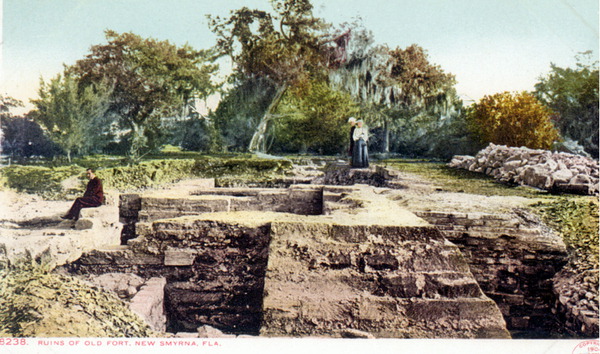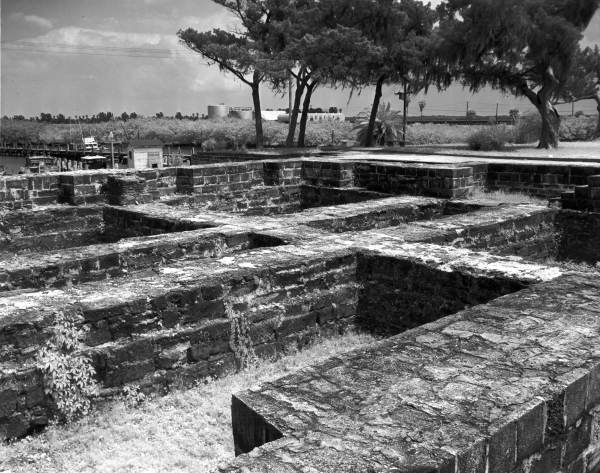By Rachel Williams
The coquina foundation found at the intersection of North Riverside Drive and Washington Street in New Smyrna Beach is a relic of an 18th-century structure, often referred to as the “Old Fort Ruins” or “Turnbull Ruins.” This site holds significant historical value, as it dates back to the initial British settlement of New Smyrna in East Florida.

Postcard of the Turnbull Ruins
A Scotsman’s Florida plantation
Following the conclusion of the Seven Years’ War in 1763, Britain gained control of Florida from Spain and divided the territory into East and West Florida. Many Spanish residents fled to Cuba, leaving the colony sparsely populated. In an effort to encourage settlement and agricultural development, Britain offered land grants to those willing to clear the land and cultivate cash crops such as silk, cotton, and indigo.
In 1766, Dr. Andrew Turnbull, a Scotsman, took on the challenge of establishing a plantation in East Florida. He received a 20,000-acre land grant from the British crown and selected a location approximately 75 miles south of St. Augustine. The acreage eventually expanded to 60,000 when Turnbull partnered with Sir William Duncan, physician to King George III, and George Grenville, former prime minister of Britain.
The new settlement was named New Smyrna after Smyrna, a significant port city of the Ottoman Empire and the hometown of Turnbull’s wife. Today this port city is called Izmir, located in modern-day Turkey.

Andrew Turnbull
Recruiting Mediterranean workers
As British consul in the Ottoman Empire, Turnbull had witnessed the diligence of the Greek population and decided to recruit laborers from the area for this new venture. In 1767, he traveled to the Mediterranean and successfully recruited 1,403 people, primarily from the island of Minorca, as well as others from Italy and Corsican Greeks.
Turnbull sought to recruit people from areas experiencing hardships such as intense weather affecting harvests, or political discontent. To further incentivize leaving their homeland for the New World, Turnbull promised them land in exchange for several years of their labor.
Their journey across the Atlantic proved perilous. After two and a half months at sea, only 1,255 of the original 1,403 settlers survived to reach New Smyrna in the summer of 1768. Upon arrival, they found the settlement unprepared; housing was insufficient, food supplies were inadequate, and clean water was scarce.
Within a month of their arrival, discontent boiled over into a revolt on Aug. 19, 1768. The revolt, led primarily by Italians, was driven by the poor living conditions and ongoing toll of disease. A group of settlers attempted to flee to Cuba but were captured by troops. One man was killed in this debacle, for which two men were found responsible and executed.
A harsh life breeds discontent
Life at the New Smyrna plantation remained harsh, with high mortality rates due to disease and malnutrition. By 1769, over half of the settlers had died. Although Turnbull constructed a hospital, it was likely overwhelmed and understaffed. Food rations were meager, and settlers faced brutal treatment by overseers. Accounts vary on the extent of these hardships, with some accounts describing severe restrictions on food and even prohibitions on fishing, while Turnbull’s records suggest otherwise.
Despite some successful harvests of indigo between 1771 and 1773, the plantation’s fortunes declined as the soil became depleted of nutrients. Droughts in 1774 and 1775 further exacerbated the situation, leading to crop failures and starvation. Turnbull, however, attributed the poor crop yields solely to the droughts, ignoring the long-term damage to the soil caused by intense farming practices.
Discontent continued to grow among the settlers, fueled by rumors that their labor contracts would not be honored and by the broader unrest of the American Revolution. In 1776, while Turnbull was in England, three settlers walked to St. Augustine to present their grievances to Gov. Patrick Tonyn, a political adversary of Turnbull.

Turnbull Ruins
The end of a colony
Sympathetic to the settlers’ plight, the governor agreed to terminate their contracts. By April 1777, nearly 600 settlers had relocated to St. Augustine, leaving the New Smyrna settlement effectively dissolved. Some settlers remained, hoping to receive the land they were promised. Some descendants of these settlers remain in the area today.
Turnbull himself relocated to Charleston, South Carolina, where he operated an apothecary until his death in 1792. When Spain regained control of Florida in 1783, the Spanish government issues land grants to the remaining settlers.
Today, the “Turnbull Ruins” in New Smyrna stand as a testament to his early colonial endeavor, though the exact purpose of the structure remains debated. Some suggest that the ruins were part of a warehouse, while others think they may have been intended as a church or the foundation of a manor house for Turnbull’s partner, William Duncan. Regardless of its original purpose, the site serves as a poignant reminder of the challenges faced by the early settlers of New Smyrna.
Images from the State Archives of Florida

